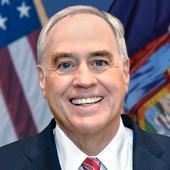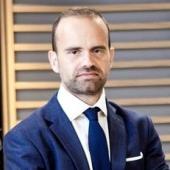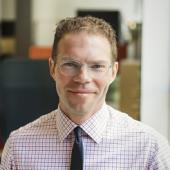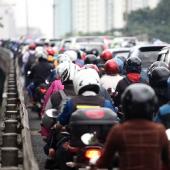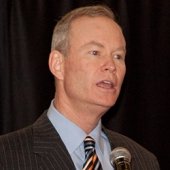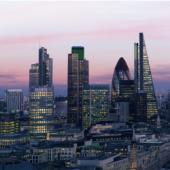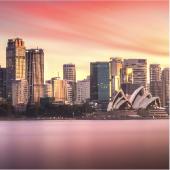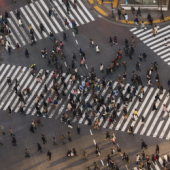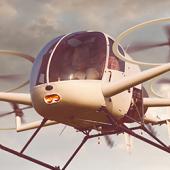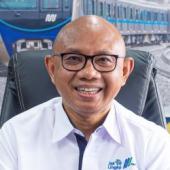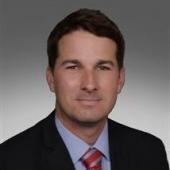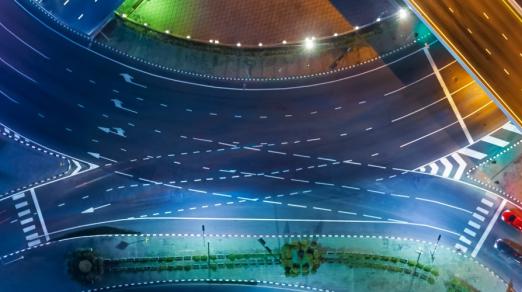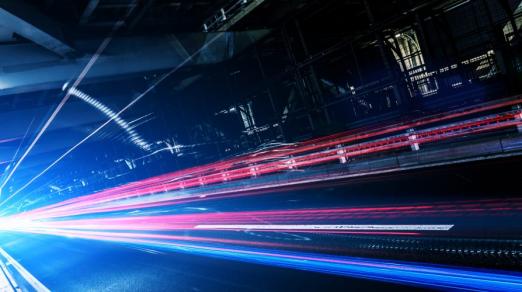How to build safer and more sustainable smart cities of the future
IN BRIEF
- 3:28 – We are at an inflection point where: “Cities are becoming the focus of the human experience. The good news is that we have the technology to meet our needs, and the challenges are big but certainly the opportunities are sizable, too."
- 4:40 – Economic shifts in the aftermath of COVID: “What does the tax based for a city look like. Is the way they’ve been gathering revenue and spending money something that is going to continue or are they going to have to think differently about what financial stability looks like?"
- 18:50 – Programmable cities: “Can we change an area of a city to go from a loading zone to a thoroughfare to maybe a soccer field on Sundays? Geospatial capability will enable this to happen. Everyone will have localization capability in their hands by the end of the decade, if not sooner. We can change the nature of cities, almost program them. We can expect that by 2030.”
Smart cities will create some $2.5 trillion of opportunity by 2025. The convergence of technology, such as AI, machine learning, and big data are disrupting how people move around cities and how cities interact with those people. In this video, VISION by Protiviti's Editor-in-Chief Joe Kornik discusses this and other smart city opportunities with three expert panelists: Vaibhav Ghadiok, Co-Founder and Vice President of Engineering at Hayden AI; Renee Autumn Ray, Strategy and Innovation leader at Conduent; and Jonathan Reichental, professor, bestselling author and smart cities expert.
HOW TO BUILD SAFER AND MORE SUSTAINABLE SMART CITIES OF THE FUTURE - Video transcript
Joe Kornik: Welcome to the VISION by Protiviti interview. I’m Joe Kornik, Director of Brand Publishing and Editor-in-Chief of VISION by Protiviti, our content initiative where we look into the future to examine the strategic implications of big topics that will impact the C-Suite and executive board rooms worldwide. This, our first topic, “The Future of Cities,” we’re exploring the evolution of urban areas that are undergoing post-COVID and how those changes will alter cities over the next decade and beyond. Today, we’re joined by a panel of smart cities experts, particularly when it comes to transportation, mobility, and sustainability, and how they all impact both the public and private sector. The disruption is already underway, of course, and changes are happening so fast that it’s often difficult to keep up. Fortunately, we’ve got three people here to help us make sense of it all.
Today, I’m joined by Vaibhav Ghadiok, Co-Founder and Vice President of Engineering at Hayden AI, developers of the first ever autonomous traffic management platform for cities. I’m also joined by Renee Autumn Ray, Strategy and Innovation leader at Conduent, where she leads partnerships for Conduent transportation, a technology company which includes payment processing enforcement and data analytics for public safety and transit. Finally, we have Jonathan Reichental, Ph.D., professor, bestselling author and smart cities expert. Thanks so much for joining me today. Jonathan, let’s start there with the study that I know you like to cite. It’s from Frost & Sullivan, which suggests, “Smart cities will create some $2.5 trillion of opportunity by 2025. The convergence of technology, such as AI, machine learning, and big data are disrupting how people move around cities and how cities interact with those people.
Let’s start where we are today, and then discuss what’s coming down the road. Where are the opportunities and how can we make sure that we’re building better, safer, and more sustainable cities of the future? I’ll open that question up to all three of our panelists.
Jonathan Reichental: Great to be here, Joe. This looks like it’s going to be the century of cities. We are now a majority urban planet, and over the next few decades, millions more will move into cities. Our cities have served us well generally. We identify with some big challenges, but they are now under considerable duress, whether it’s the ability to tap into clean, abundant energy, protect the environment, offer up transportation services, have a safe and healthy environment. These are all things that now we need to focus on, and we are beginning to focus on as the issues and challenges arise. The good news is, leaders around the world are embracing an urban future, recognize the needs of cities, and they’re beginning to invest and they’re beginning to look at technology in particular, things like artificial intelligence, internet of things, data in a very big way. We see amazing solutions, whether it’s in dynamic traffic signal systems to make traffic move more smoothly or sensors that detect whether water is healthy and air is healthy. We are in this incredible inflexion point, I believe, becoming really clear in my travels around the world where cities are becoming the focus of the human experience. The good news is, we get technology to meet it, but the challenges are big, and certainly, the opportunities are sizeable too.
Kornik: Renee, why don’t you share some thoughts around that same question?
Renee Autumn Ray: Sure. There are a couple of things that I think are really important opportunities for cities. One is that we know that travel behavior is something that is very much engrained and is very hard to change. Certainly with COVID, we’ve seen people are changing the way that they work, the way that they go to school, the kinds of errands they’re running. We’re still trying to understand how much of travel is going to go back to normal and how much of it is going to stay different. When we think about where we have spent a lot of our effort in dollars, it has been on commute trips, which are actually just under a fifth of all trips taken. I think this gives us an opportunity to focus on what should the entire mobility system look like for all kinds of trips and for all kinds of people. Something else, I think, is really important, is there are big economic shifts that are happening in the aftermath of COVID and they’re going to change what the tax base for a city looks like, is the way that they have been gathering revenue and spending money something that’s going to be able to continue in the future, or they’re going to have to think differently about what financial sustainability looks like and where they are drawing resources from, and how they are spending their budget in ways that are more equitable for the folks that live there.
Kornik: Interesting. Vaibhav?
Vaibhav Ghadiok: Sure. My perspective is more transportation related, so let’s look at where we are today. Bus speeds in pre-COVID Manhattan were less than five miles per hour. A typical job today is only accessible by about 27% of its metropolitan population in 90 minutes or less. Really, the transportation today, not very equitable for those people depending on public transportation as their primary means of transportation. It is not working. The system is not working for them. Lastly, we have an overburdened transportation system. Now, when you start thinking about fixing these problems, we are often thinking big, big infrastructure project, big capital expenditure, projects taking decades maybe. In the same breadth, we also talk about Smart Cities, so why not talk about smart expenditure and think small? What can be achieved with the technology today where we can deploy, say, mobile sensors, much like Hayden AI does, that are AI enabled and spatially aware. We have these sensors that we can mount on city fleet vehicles. As the vehicle goes through the city, it has a full understanding of what it has seen. It can observe things, report things. What impact can that have without large expenditure? That is where I think we have to go next or think next.
Kornik: I know both Hayden AI and Conduent are focused on the public aspect of this in terms of public transport and mobility, as well as other areas. Renee, if you could, talk to me a little bit about how public spaces could be different in cities of the future and why that’s so important that we get it right.
Ray: Yes, absolutely. Streets are, often times, a very significant portion of the total land available in the city. Virtually all of them are going to be public. They’re public spaces and they’re spaces for people to travel, but also to congregate and to gather. I think certainly, what we see in a number of cities implementing in terms of parklets or in terms of making a few blocks pedestrian only, either for certain days or even permanently, is something that is likely to continue and expand in the future. So, when you think about the role of a city as an economic engine but also a place where people want to have quality of life, they’re increasingly able to choose where they live and where they work based on those quality of life factors, you can see how challenging it is for city government to balance the needs of those mobility needs, the quality of life needs of their residents, along with just the prosaic things like can groceries get the freight they need to have delivered by trucks. There is a lot of pressure on this public resource, and I think that also creates opportunities for cities to say, if we’re going to change the balance of how much of our street network is given over to private vehicles, to private loading zones for deliveries, we have to balance that with being able to capture revenue from the spaces that we leave available and make sure that if we open up spaces for residents to be walking, to be sitting, to be congregating, that we’re capturing the value of that in creating a better place for people to live in. Those are going to be really hard questions. They’re going to be very politically challenging questions, but there are places where we need government to be a leader in terms of helping us come to those decisions and make sure that cities are places that people want to live and are not just forced to live in order to have a good job.
Kornik: Vaibhav, I know this is a big part of Hayden AI’s VISION, of what’s possible in the future. If you could, share with me some of those possibilities and what their overall impact could be on the future of cities.
Ghadiok: Absolutely. Let’s talk about a few use cases and what is the impact, what is the potential impact for that. One of the first use cases we said is what’s called automated bus lane and crosswalk. There are cities with dedicated bus lane, people come in, park their cars, slowing down the buses, increasing ridership, increasing cost for the MTA. Now, what we’ve seen with limited pilots is bus speeds. We’ve been able to increase bus speeds almost by 55%, for instance, in the M14 Manhattan route. This impacts almost 44,000 people who use this bus route daily. So, massive impact, think small. It’s a small little mobile sensor, look at the impact it could have. Let’s look at another use case, bike lanes. If we enforce using the same technology, we enforce bike lanes, make sure it’s clear, give people an opportunity to ride their bikes in cities, increase the throughput of our streets, we can make this a lot safer. Parking, with our spatially aware sensors, we are able to see if there are parking spots that are empty. We can redirect people to those empty parking spots. What we have learned from survey after survey, that up to about 30% congestion in urban downtowns is caused by people circling, trying to find parkings. Again, massive impact with this technology. Lastly, what I can tell you is traffic signaling. We have outdated traffic signaling timing that causes more than 10% of traffic delays in most urban routes. Again, with more data, et cetera, we can make these traffic signals a lot more dynamic, again, have a massive impact on this without a lot of capital expenditure.
Kornik: We focused a lot so far on the public sector’s aspect of this. Jonathan, if you could, let’s talk a little bit about the private sector’s role in the future of Smart Cities in terms of both opportunity and what’s possible. Your perspective here is really valuable. One, there is so much potential for investment in this sector and two, smarter, more connected, and ultimately better cities are really a smart business, aren’t they?
Reichental: Yes, that’s very, very true. Everybody has a different sense of what a city is, but when you catalog it, you see that it’s a place that focuses on health, that focuses on buildings, on energy, on public safety, on telecommunications. It’s a very, very long list. In every one of those areas, there’s opportunity today. Each one is catching up with the private sector to deliver what communities expect, so there’s a catch-up period, but then there’s just these gaps of how can cities and governments deliver experiences that people are so used to in the private sector but don’t get in the public sector. Then, public sector is very much motivated to deliver better solutions because it reduces cost, which can be passed on to communities. It can create a better experience. It can get more people engaged in democracy and in the conversation. If you’re a private sector organization, this is a really wide open space for entering, bringing to the attention of mayors and city managers, incredible new ways of thinking about solving big, intractable issues, like transportation and congestion, and everything that goes with how you move people and goods around. This is remarkably open.
Lastly, I suppose, for the private sector and as a benefactor of the public sector, there are more tools in the tool kit. There are more ways now to deliver solutions. In the public sector, the digital transformation is just beginning, and if we can combine new thinking about the future, focusing on people and quality of life, I think there’s a very healthy future for private organizations to participate. The data certainly reflects that. I just say finally, here’s an amazing industry, the public sector industry for start-ups and new companies to enter where they didn’t enter before. This is an area of the economy that I’m actually quite bullish on. I think if we do a series of the right things, incorporating the right technologies, we’re looking at multi-trillions of new opportunity over the next decade and beyond.
Kornik: Yes, Jonathan, that’s a really good point and a really good segue way into my last question. Before I let you all go, we call this program “VISION by Protiviti” because we like to get really smart people with innovative ideas to talk about their vision of the future. Smart cities and transportation in 2030, what’s possible when you think about the next decade, and even beyond when we talk about the future of cities? Renee, why don’t you start us off?
Ray: Sure. When I think about what I want the future of cities to be like, I think of it more as an experience than something that I’m going to see. I think about feeling less stressed when I’m travelling through a city, whatever kind of errands I’m running. I think about if I’m driving in a city, having a more seamless experience to get in my car, map my route, reserve a parking space, pay for it, and have that be something that’s really easy and seamless for me to do. I think that one of the ways that we can get there, besides just technology, is by having measurable outcomes so that we can hold cities to a standard of ensuring that they are improving mobility options across different modes for different people, whether we’re talking about how easy is it to get to work, how many jobs can you access from your home, how easy it is for you to get to the grocery store, take your kids to drop them off at daycare; and being able to collect and evaluate data with technology is going to be a big part of how we’re able to do that.
Reichental: I’d like to actually build on what Renee is saying. A lot of what will happen over the next decade, some of it will be invisible as we build out the digital infrastructure to support a lot of the experiences that community members will have, the improved experiences. If you want to know about what we’ll see, how it will look differently, I want to point to two big areas. I think these will resonate with people. The first one is the introduction of autonomous vehicles at scale. I believe that we are a looking at a driverless feature because I’ve experienced driverless cars and I’m absolutely convinced that our roads will be populated by an assortment of new innovation that has been driven by computers, not humans. That allows us to change how we design and plan cities, it’s a really big deal. The second visible area that I think we’ll all notice, and it will happen faster I think than we anticipate, will be the introduction of drones, both on the street and also in the skies. It’s a space where the evidence is so clear now that this is coming, I would encourage not only the private sector but the public sector to begin the preparation for that. We need the legislation and the regulation. We got to be ready for it.
Finally, my final point would be, we can’t look out to the future without thinking about resilience and the particular changes in the climate, which over the next 10 years will be increasingly more visible. Cities will be making steps and taking steps, in fact, to mitigate a whole range of natural issues and the human made issues. By the way, I have one more, sorry, which is, it goes back to something Renee said very early on in our conversation. I think based on what I’m seeing in many major metropolitan areas around the world is more focused on place making. I like to think about this as we built cities in the 20th century largely around the automobile. The 21st century is about building cities around people. I think visibly, you’ll see cities start to make sort of central areas, more pedestrian and more friendly to humans. Smart cities are ultimately about people experiences. We shouldn’t get distracted by the technology. If it works well, it’s invisible.
Ghadiok: Let me give a technologist point of view. [Laughter] There were some remarkable points made by both Renee and Jonathan. Let’s first talk about maybe autonomous driving. I think there have been massive advances in machine learning, especially applied to computer vision in the past decade, which has enabled various applications. However, safety critical applications that require, say, six nines reliability, such as autonomous driving, remain elusive. I do believe somewhat guided autonomous driving or under supervision is going to happen in the next few years on highways, however city centers remain a challenge. One way to solve that problem is to use the kind of AI sensors, AI innate sensors to provide data to these semi-autonomous, autonomous vehicles so they know what to expect at an intersection 300 meters before they even approach it, especially in areas where there’s conflicts. There are a lot of, again, playlists for having these intelligent sensors spread across the city. Another idea to build upon what Renee said a little earlier in this segment was about cities and how cities — the way I would think about is how they can be made programmable so to speak. Can we change a certain area from a loading zone to a fair to maybe a soccer field on Sundays? Now, what’s going to enable this change is a geospatial capability. Now, everybody in their hands is going to have localization capability of about 50 centimeters of beta by the end of this decade or potentially sooner. Now, as my vehicle goes down the road, it can point to me, here is a vacant parking spot even though there is no marking or anything. We can visually change the nature of cities from one hour to the next, almost program them so to speak. I think that is a future that we can definitely expect before 2030. The autonomy, I would say let’s give it a decade or more. [Laughter]
Kornik: Thank you so much for all of those futuristic outlooks. It’s an exciting time, the technology moves very fast. We’re trying to keep up with it. Thank you so much for allowing us to get a better sense of how it’s moving and what’s coming. Vaibhav, Renee and Jonathan, thank you so much for your time today. I really appreciate you participating in our program and thanks again.
Renee Autumn Ray is a Strategy and Innovation leader at Conduent.
Vaibhav Ghadiok is Co-Founder and Vice President of Engineering at Hayden AI.
Jonathan Reichental is a professor, bestselling author and smart cities expert.




